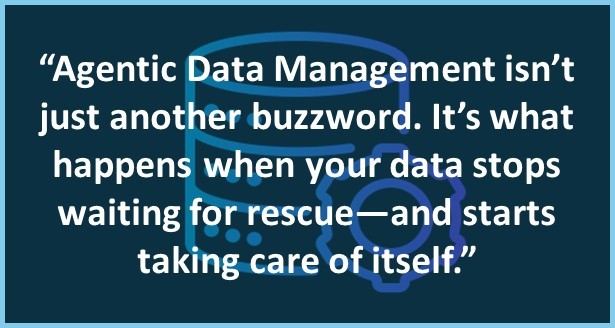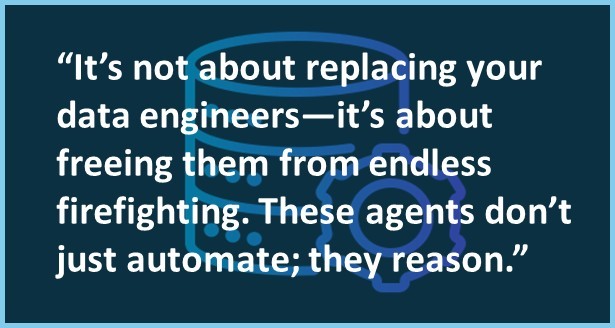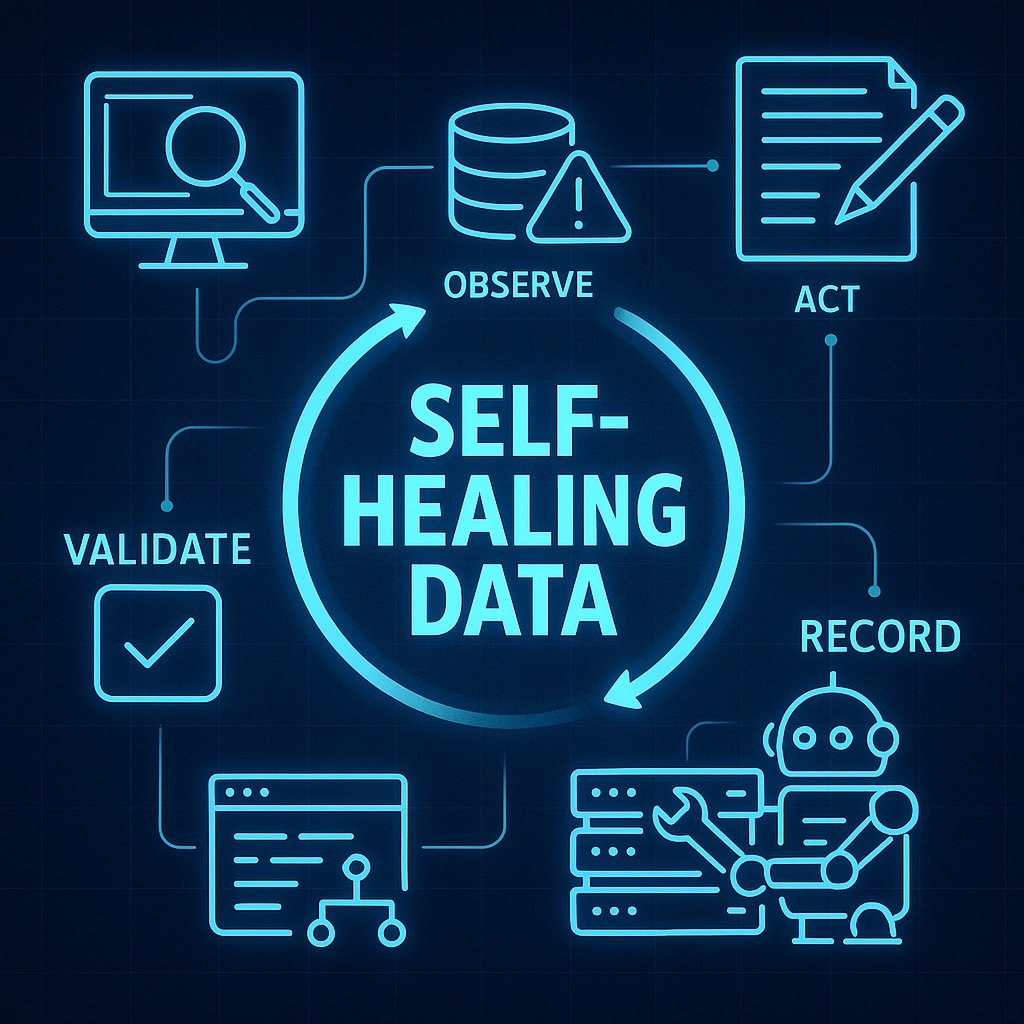By JD Woods
We’ve all seen it, one bad data job takes down half a dashboard, the analytics team scrambles, and your Monday turns into a “who broke what” mystery. Now imagine that same pipeline detecting the problem, finding the source, fixing it, validating the results, and documenting the change, all before lunch.
Welcome to Agentic Data Management, or ADM for short. It’s what happens when artificial intelligence meets data governance and decides to start cleaning up after itself.
What Is Agentic Data Management, Really?
Think of it as a digital pit crew for your data. Agentic Data Management combines AI “agents” with observability and governance tools to:
Monitor data quality and performance (freshness, drift, missing values).
Diagnose issues, where they started, what they broke, who’s affected.
Propose or perform a fix, with full documentation.
Validate the change before anything goes live.
Log every step for audit and compliance.
It’s not about replacing your data engineers; it’s about freeing them from endless firefighting. These agents don’t just automate; they reason. They understand the rules of your business and act within them.
“Business users can now harness AI data agents with unified governance—ensuring every action inherits access controls, policies, and masking rules.”
Snowflake Blog, 2025 Tweet
Why You Should Care (Even If You’re Not a Data Scientist)
Every business runs on data, and every executive has asked, “Why do our reports keep changing?” ADM tackles that by making data more reliable, more compliant, and far less expensive to maintain.

Here’s what’s in it for you:
Less downtime and panic. ADM shortens Mean Time to Resolution (MTTR), how long it takes to fix a data problem, by automatically finding and addressing root causes.
Better decisions. Fewer bad data points mean better forecasts, smarter dashboards, and happier clients.
Proof of compliance. Every fix, rollback, and validation is logged, giving auditors the digital equivalent of a neatly labeled binder.
Lower costs. Fewer failed runs, fewer “emergency” reprocessing cycles, and fewer late-night calls to your data team.
That’s not just cool, it’s quietly transformative.
How the “Self-Healing” Magic Works
Let’s pull the curtain back. Here’s the basic loop most ADM systems follow:
Observe – The system spots an anomaly (say, a data freshness lag or schema drift).
Reason – The agent traces lineage, identifies the likely cause, and proposes a fix.
Act – It executes the change (updating a query, rerunning a job, or quarantining data).
Validate – It tests results before release.
Record – It logs the who/what/when/why for governance.
You could call this “autonomic data operations.” We call it business peace of mind.
Who’s Making It Real (and How)
This isn’t a lab concept. It’s already landing in the enterprise stack.
Snowflake has rolled out AI Data Agents that can reason across data governance boundaries while respecting every security control.
Databricks introduced Agent Bricks, allowing AI-driven assistants to propose and test data fixes directly in production-like environments, safely, and under human supervision.
Salesforce, through its Agentforce initiative, is connecting agentic logic to CRM and analytics pipelines, blending data hygiene with customer insight in real time.
Together, these platforms show us where enterprise automation is heading – not just faster, but smarter.
“People underestimate how hard it is to completely automate tasks… humans will continue to play a crucial supervisory role.”
Ali Ghodsi, Databricks CEO Tweet
What “Self-Healing” Really Means
Let’s be clear, this isn’t science fiction (yet). The “self” in self-healing still includes humans in the loop. The system proposes, the humans approve, and together they build a tighter feedback cycle.
It’s automation with a conscience.
But when it’s working right, you’ll see:
Broken data jobs quarantined automatically.
Schema mismatches patched with proposed fixes.
Pipeline reruns triggered intelligently based on service-level expectations.
Audit logs auto-generated for compliance reviews.
Like a good immune system, the process works quietly until it needs to make some noise.
WWG Recommends These Simple First Steps
If you’re intrigued (and you should be), here’s where to start—no new infrastructure, no moonshots required:
- Start observing. Turn on or upgrade your data observability tools in Snowflake, Databricks, or Salesforce Data Cloud. Measure the freshness, quality, and volume of your top five critical pipelines.
- Define “safe” actions. Document which automated responses are acceptable, like quarantining suspect data or rerunning a job.
- Automate alerts and responses. Use event-driven tools such as Microsoft Fabric’s Data Activator or Salesforce Flow to connect detection with response.
- Stay in control. Build approval steps into any automated workflow, humans should always have veto power.
- Measure impact. Track how long it takes to detect and fix a data issue before and after implementing these steps. That’s your MTTR,watch it drop.

A Balanced View: The Pros and the Cautions
Pros:
Real-time visibility and faster recovery.
Stronger compliance through continuous documentation.
Smarter use of human talent – less triage, more innovation.
Cautions:
Over-automation can hide problems if guardrails aren’t enforced.
There are real costs in computing and monitoring at scale.
The technology is still maturing; not every promise is production-ready.
In short, your data can now “heal” itself, but you still need a good doctor on call.
Final Thought
Agentic Data Management isn’t just another buzzword. It’s the next evolution of how businesses handle complexity. The same way we once marveled at self-driving cars, we’re now watching data pipelines start to drive themselves—with the same mix of excitement and healthy skepticism.
And that, frankly, is what makes it worth paying attention to.
About Weiwood Group
Weiwood Group helps organizations find their Flow, Engagement, and Thrive Momentum, driving smarter operations, sharper strategy, and stronger teams. Led by John David “JD” Woods, a veteran operations and transformation executive, the firm brings an injection of Business How to complex challenges in technology, logistics, healthcare, and field services.


